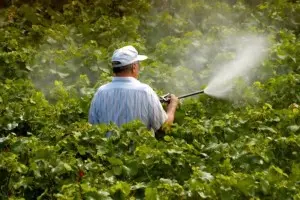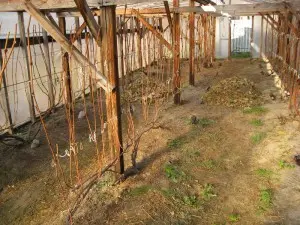Contents
Spring processing of grapes includes many nuances and begins with the correct opening of a bush under winter shelter. This will be discussed in the article.
In areas with a low risk of frost, grapes are opened immediately when the air temperature rises above -2-0 C. If the site is prone to frost or they are expected, then ventilation holes are made in the shelter in the spring and it is completely removed only after bud germination and the appearance of a green cone . Then the grapes are directly processed, and not only the vine and leaves are sprayed, but also the ground in the root zone, which significantly reduces the likelihood of infection of the bush with a disease or some kind of pest.
How to process grapes?
Before the grapes are treated with special preparations in the spring, it is necessary to tie the bushes on a trellis or wire in order to raise the vine and leaves from the ground. Since after the snow melts and heavy rains, waterlogging of the vineyard is possible, and this can lead to infection of the grapes with a disease such as mildew. The garter is carried out in dry weather. In practice, gardeners use several means to treat a bush, for example, 3% iron sulfate, 1,5-3% solution of Bordeaux liquid, Ridomil or Zineb.
Bordeaux liquid
Special care should be taken when using a solution of Bordeaux mixture, as the drug is very toxic in high concentrations. If there is already a green cone on the vine, the concentration of the solution should be 0,7-1%, and 2,5-3% if the grapes have not yet begun to grow. The bush is treated with a warm mixture, the temperature of which is 24-36 C. Although it is effective for the prevention of many diseases, for example, gray rot, anthracnose, oidium or mildew, this remedy has been used as a treatment much less recently. Exaggeration of the dose can inhibit the development of grapes and young growth.

inkstone
Iron sulfate helps protect the vine from spring frosts. It should be borne in mind that the agent begins to act on the treated plant after 1-1,5 days, so the treatment of swollen buds is carried out a few days before the temperature drops. The duration of action of vitriol is 7-10 days.
Ridomil
Ridomil, by far, is the most popular remedy. With relatively low toxicity, the drug effectively protects shoots and leaves from a number of diseases, even in the season of heavy rains. The duration of its action is 12-15 days. To combat bacterial and fungal diseases, biofungicides and fungicides are used.
In places where the vines are cut in spring, the flow of juice is observed. To stop this process, 4-8 g of complex conventional fertilizer, with a low content of trace elements, such as Nitrophoska or Kemiru, should be applied. After that, the earth is shallowly dug up and watered to increase the temperature in the soil of the root system. If there are several varieties of grapes on the site, fertilizer should be applied to all bushes at the same time, when the first “tears” appear in early varieties.

Processing calendar
Due to the different climatic conditions, it is almost impossible to draw up a general plan for the processing of grapes and set specific dates for all regions. You can adjust the spraying time yourself by observing the development of your own bush and, based on the observations, draw up a more suitable treatment table.
Before processing grapes from pests and diseases, it is necessary to carry out a number of agrotechnical measures – to correct the recesses in the trellis rows, break up large clods of earth and level it between the rows, cut and tie up the bushes. To stop the foci of the disease that has appeared, it is necessary to remove the affected leaves as soon as possible and burn them in a remote place. Although modern horticultural practice has bred varieties that are resistant to many diseases, the chance of infection is high without proper care.

In the presence of plant diseases in the past year, the bush is treated with Actellik according to the instructions, with swelling and opening of the kidneys. Immediately after the rainy season at the end of April, if there are at least 4-6 true leaves, the grapes are treated with a fungicide. It must be borne in mind that the preparations protect only those parts of the plant with which they have come into contact. Therefore, special attention should be paid to the lower part of the foliage, since the development of the disease occurs in this zone. The fourth treatment, as a rule, is carried out before flowering – in the second half of April and mid-May, using a complex of preparations such as Ridomil, Topaz and Actellik. It prevents the appearance of mildew and powdery mildew on the plant. After another 18-20 days, a second final treatment is carried out after flowering, when the size of the berries reaches 2-5 mm, to consolidate the result.
As a rule, processing on this ends before the very closing of the vine. In case of detection of diseases, additional processing is carried out. If it is rainy weather, with fogs and dew in the morning, they are treated with Thanos, Delann or Oxyhom; in dry hot weather – Topaz, Strobi, Thiovit Jet.
Video “Processing grapes from diseases and pests”
How to carry out the first processing of grapes in the spring, what means to give preference to save your personal budget, but not lose efficiency, this video tells.









